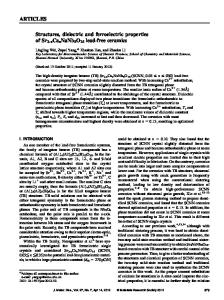Microwave dielectric properties and vibrational spectroscopic analysis of MgTe 2 O 5 ceramics
- PDF / 546,211 Bytes
- 6 Pages / 585 x 783 pts Page_size
- 5 Downloads / 393 Views
R. Ratheesh Microwave Materials Division, Centre for Materials in Electronics (C-MET), Thrissur-680 771, India
M.V. Jacob School of Engineering, James Cook University, Townsville, QLD 4811, Australia
M.T. Sebastiana) Materials and Minerals Division, National Institute for Interdisciplinary Science and Technology (NIST), Trivandrum-695 019, India (Received 10 August 2007; accepted 12 December 2007)
MgTe2O5 ceramics were prepared by solid-state route. These materials were sintered in the temperature range of 640–720 °C. The structure and microstructure of the compound was investigated using x-ray diffraction (XRD), Fourier transform infrared (FTIR), Raman spectroscopy, and scanning electron microscopy (SEM) techniques. The dielectric properties of the ceramics were studied in the frequency range 4–6 GHz. The MgTe2O5 ceramics have a dielectric constant (⑀r) of 10.5, quality factors (Qu × f) of 61000 at 5.3 GHz, and temperature coefficient of resonant frequency (f) of −45 ppm/°C at the optimized sintering temperature of 700 °C. The microwave dielectric properties of these materials at cryogenic temperatures were also investigated. I. INTRODUCTION
Extensive research has been carried on the microwave ceramics for their use in telecommunication systems.1–4 Recently, low-temperature cofired ceramic (LTCC) technology has become critically important in the development of electronic devices for wireless communication.1–4 The use of LTCC technology can also facilitate integration of passive components and has the ability to use highly conductive and inexpensive metallization, quick prototyping, compact structures, and integration.3 For the cofiring process, the melting point of electrode determines the sintering temperature of the LTCC module. However, reducing the sintering temperature without affecting properties is a challenging problem in LTCC material research.5,6 The sintering temperature of the ceramics can be lowered by the addition of low melting glasses, chemical processing, and small particle size of starting materials.7 However, chemical synthesis complicates the fabrication method and also increases the cost of production. Addition of glasses leads to poor dielectric properties and also increases the chance of chemical reaction with metal electrodes.8,9 The soldering of LTCC tapes can cause formation of cracks due to the difference
a)
Address all correspondence to this author. e-mail: [email protected] DOI: 10.1557/JMR.2008.0212 J. Mater. Res., Vol. 23, No. 6, Jun 2008
http://journals.cambridge.org
Downloaded: 19 Mar 2015
in thermal expansion coefficients of the glass and ceramics.8,9 Thus, glass-free materials with good microwave properties are strongly advised for LTCC applications. Even though a large number of low-temperature sinterable microwave dielectric materials are reported, the stringent requirements of the LTCC technology has forced researchers to find more suitable candidates. Recently, a number of tellurium-based low-temperature sinterable dielectric resonator materials have been reported
Data Loading...











